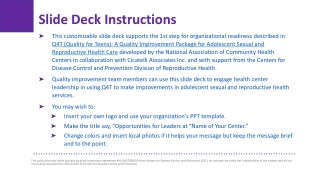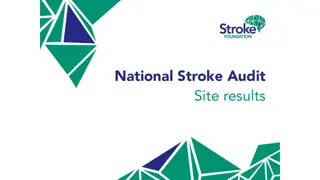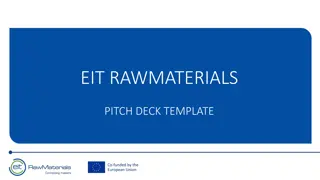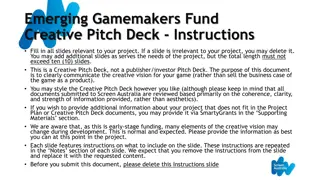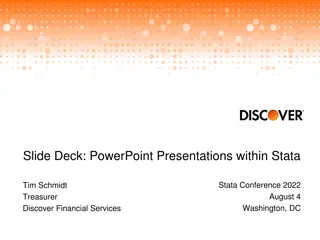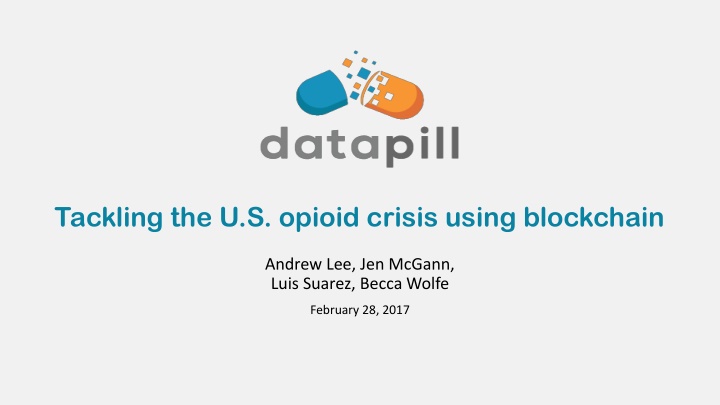
Tackling the US Opioid Crisis with Blockchain Implementation
Addressing the severe opioid epidemic in the US by leveraging blockchain technology to improve tracking and monitoring of prescription histories across stakeholders. Current efforts are deemed insufficient due to lack of technology and transparency, with the need for enhanced regulation and education highlighted.
Download Presentation

Please find below an Image/Link to download the presentation.
The content on the website is provided AS IS for your information and personal use only. It may not be sold, licensed, or shared on other websites without obtaining consent from the author. If you encounter any issues during the download, it is possible that the publisher has removed the file from their server.
You are allowed to download the files provided on this website for personal or commercial use, subject to the condition that they are used lawfully. All files are the property of their respective owners.
The content on the website is provided AS IS for your information and personal use only. It may not be sold, licensed, or shared on other websites without obtaining consent from the author.
E N D
Presentation Transcript
Tackling the U.S. opioid crisis using blockchain Andrew Lee, Jen McGann, Luis Suarez, Becca Wolfe February 28, 2017
Very focused. I called this one out in the conclusion because you were focused on what is feasible. Would be good to know a bit more about the mechanics of the blockchain implementation. 85/100
The U.S. has a severe opioid epidemic Health and social costs related to prescription opioid abuse is $55 billion each year 1 2 Over 650,000 opioid prescriptions are dispensed daily Patient suffers from pain 100 million Americans suffer from chronic pain Patient is prescribed a Schedule II drug Prescription drug abuse crisis in the US 5 3 Overdose, hospitalization, illegal sale of drug, death No monitoring to curb addictive behavior In 2014, 2 million Americans abused or were dependent on prescription opioids Each day, an average of 78 people die from opioid overdoses 4 Addiction 3
Lack of technology to communicate Rx history No universal method exists to track a prescription histories across all stakeholders The Payer The Doctor Cannot see if patient has prescription filled from another insurer If formulary changes even slightly, will not flag system Cannot track prescription history from previous doctors No transparency across state lines The Patient The Pharmacist Cannot see prescriptions filled at other pharmacies No time for due diligence for each patient Medication prescribed is very addictive Easy to counterfeit a script Can profit from selling drugs 4
Current efforts have marginal impact Lackluster regulation and monitoring is not addressing the source of the problem The Payer The Doctor Better education on prescribing habits (CMS, HHS) Being trained to treat the consequence (addiction) Last year, the federal government asked for an additional $1B of funding The Patient The Pharmacist Databases available to log patient use (not mandatory and does not go across state lines) Drugs come with a black box warning 5
Our solution A new system for tracking and monitoring prescription data across stakeholders Distributed among doctors, pharmacies, government Transactions validated by trusted third party Decentralized Prescription tracking software powered by a decentralized database built on an Ethereum private blockchain Each prescription creates a token for the patient to spend Transactions enabled by Ethereum smart contracts Smart SSN used as each patient s unique ID Fingerprint used to prove identity at pick-up Secure 6
How it works Prescription data will be made available to relevant stakeholders via a private blockchain Prescription is entered into a database that every doctor and pharmacy has visibility into 2 Prescription enables a token that is valid to be spent once in different pharmacies for specific period of time 3 Prescription 1 While the medicine is being consumed the patient is not allowed to buy another opioid A doctor validates that the patient needs an opioid by giving a prescription 5 Doctor Patient Token Pharmacy validates that patient has a token, takes token in exchange for medicine and makes entry to the database Pharmacy 4 7
Initial Focus for Datapill: Opiates and Opioids Focusing on one drug class increases feasibility of stakeholder alignment Opioids: Synthetic Pain Medications Opiates: A Natural Pain Remedy There are 48 classes of opiates/opioids listed as schedule 2 drugs. Within these classes there are almost 500 branded drugs and many more generic Synthetic drugs manufactured to work in a similar way to opiates Alkaloids derived from the opium poppy Types Methadone Percocet, Percodan, OxyContin (oxycodone) Vicodin, Lorcet, Lortab (hydrocodone) Demerol (pethidine) Dilaudid (hydromorphone) Duragesic (fentanyl) Types Morphine severe pain (before and after surgeries) Codeine milder pain, severe diaherrea Heroin Opium 8
$245M revenue opportunity It is important to contract with the federal government to create a national blockchain Federal State State mandated conversion and use of technology Cost of technology subsidized by state and federal Payer Doctor Pharmacy $17M $183M $45M $1/Rx written, 10% - 25% Rx Reduction Opioid Prescriptions1: 259M $0.25 $0.75 per Enrollee Total Enrollees2: 319M $250 - $300 annual fee per pharmacy Total Pharmacies3: 62K 1National Institutes of Health, America s Addiction to Opioids 2Kaiser Family Foundation, Market Share and Enrollment of Largest Three Insurers by State 3IMS Health, National Pharmacy Market Summary 9
Strong incentives across the healthcare ecosystem Datapill will serve as a shared source of truth across stakeholders Increased accuracy and fidelity Transparency incentivizes ethical behavior The Doctor Already top priority through Opioid Initiative1 Cost-savings for government-run health insurance Government Adoption to be state government mandated The Pharmacist Reduced liability, less fraudulent Rx filled Increases efficiency of pharmacists Payer Patient Cost-savings as currently bearing majority of over $55B annual cost of opioid abuse2 Reduced levels of addiction Increased convenience through electronic storage of data 1US Department of Health and Human Services, The Opioid Epidemic 2Triple Pundit, Drug Companies, Corporate Responsibility and the Prescription Opioid Crisis 10
Steps to implementation State pilot programs will begin in two years followed by gradual national rollout 1H 2021 2H 2021 1H 2020 1H 2017 2H 2018 1H 2019 2H 2019 2H 2020 1H 2018 2H 2017 Live tests of proof of concept begin Launch in 2-4 additional states Active in 10+ US states Begin pilot in Florida and California Secure funding Obtain contract with federal government Build blockchain proof of concept Test and refine product Marketing/PR/training to educate stakeholders Build partnerships with state governments Expansion and continued rollout to additional states 1US Department of Health and Human Services, The Opioid Epidemic 2Triple Pundit, Drug Companies, Corporate Responsibility and the Prescription Opioid Crisis 11
Potential risks and mitigations Ensuring stakeholder buy-in early and conducting a gradual rollout will allow us to mitigate risks Model based on scale, adoption, and enforcement Gain buy-in from federal and state governments to ensure adoption and accountability; first-to-market is critical Create public awareness around epidemic and encourage counter- lobbying from payers, providers, and pharmacists Roadblocks from pharma lobbyists Many variables to account for (losing pills, mail order, etc.) After the proof of concept, many other functions can be built in to deal with special situations The blocks have to be written and validated in small periods of time Datapill algorithms will automate blockchain monitoring, eliminating time for due diligence by doctors and pharmacists 12
Future opportunities Plan to expand beyond opioids and to explore markets outside the U.S. International expansion: Expanding focus: Prescription drug abuse is a worldwide problem Outside of U.S., opioid abuse most prevalent in Western Europe & Australia Healthcare ecosystems ripe for disruption All prescriptions to be tracked by Datapill Over 4B annually Other commonly abused prescription drugs: Depressants to treat anxiety and sleep disorders Stimulants most often prescribed to treat ADHD Prevalence of Opioid Use Worldwide Opioids 259M prescriptions annually UNODC World Drug Report 2015 13
Five-year projected cash flow Datapill is expected to start earning revenue in year 2 and turn profitable in year 3 Years 0 1 will be used to contract with the government and build the Datapill infrastructure Year 2 will begin the pilot with California and Florida while other state discussions occur 14
Our valuation Using comparable discount and growth rates for technology startups, Datapill s fair value is estimated at $429M Estimated growth rates for revenues and costs Revenue: Significant growth is not expected until year 4 once state-level discussions and implementations begin after the pilot states (FL and CA) Cost: During ramp-up and preparation for implementations, labor will be a significant cost-driver 15
Seed round ask Startup costs mostly account for labor to begin software and blockchain development $800K Seed funding will provide runway for one year: o Management (x4) o Blockchain engineer o Developer o Programmer o Government Liaison Investors will have opportunity to participate in subsequent funding rounds 16


